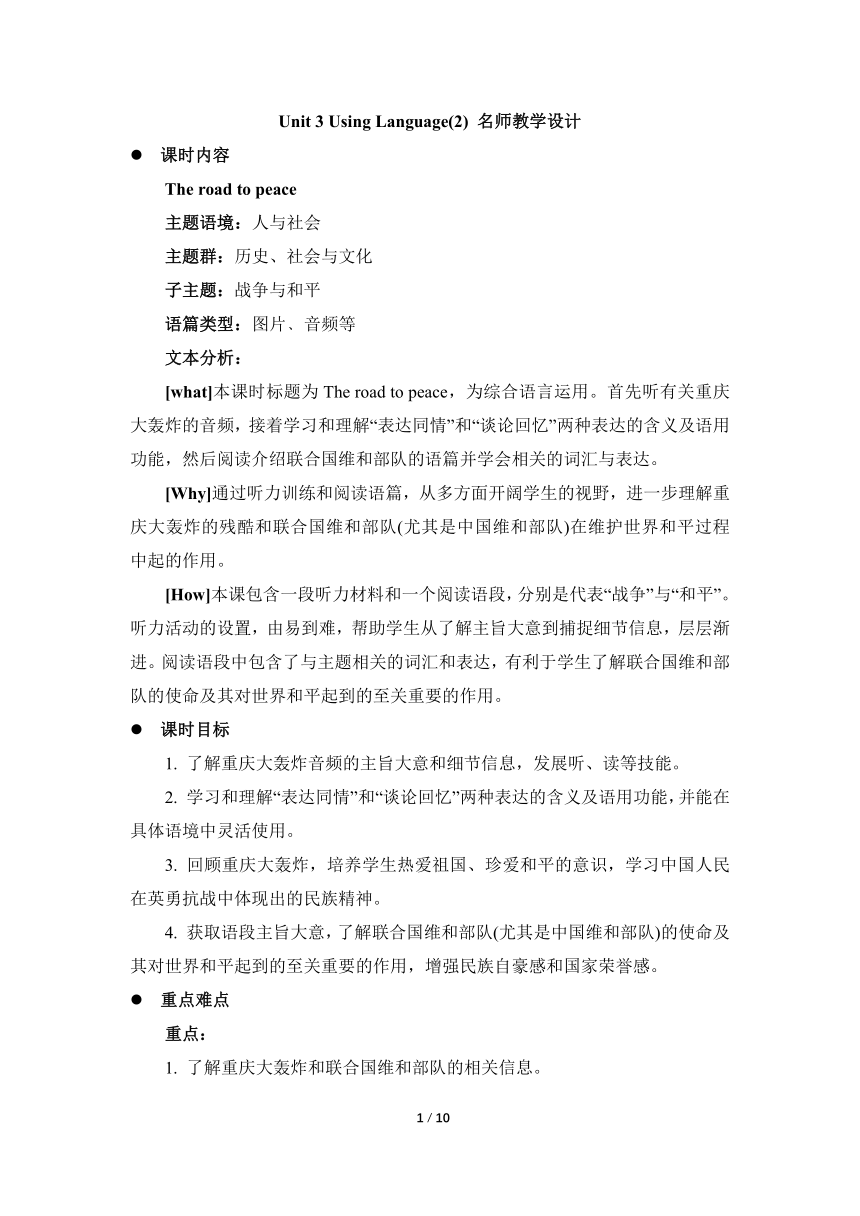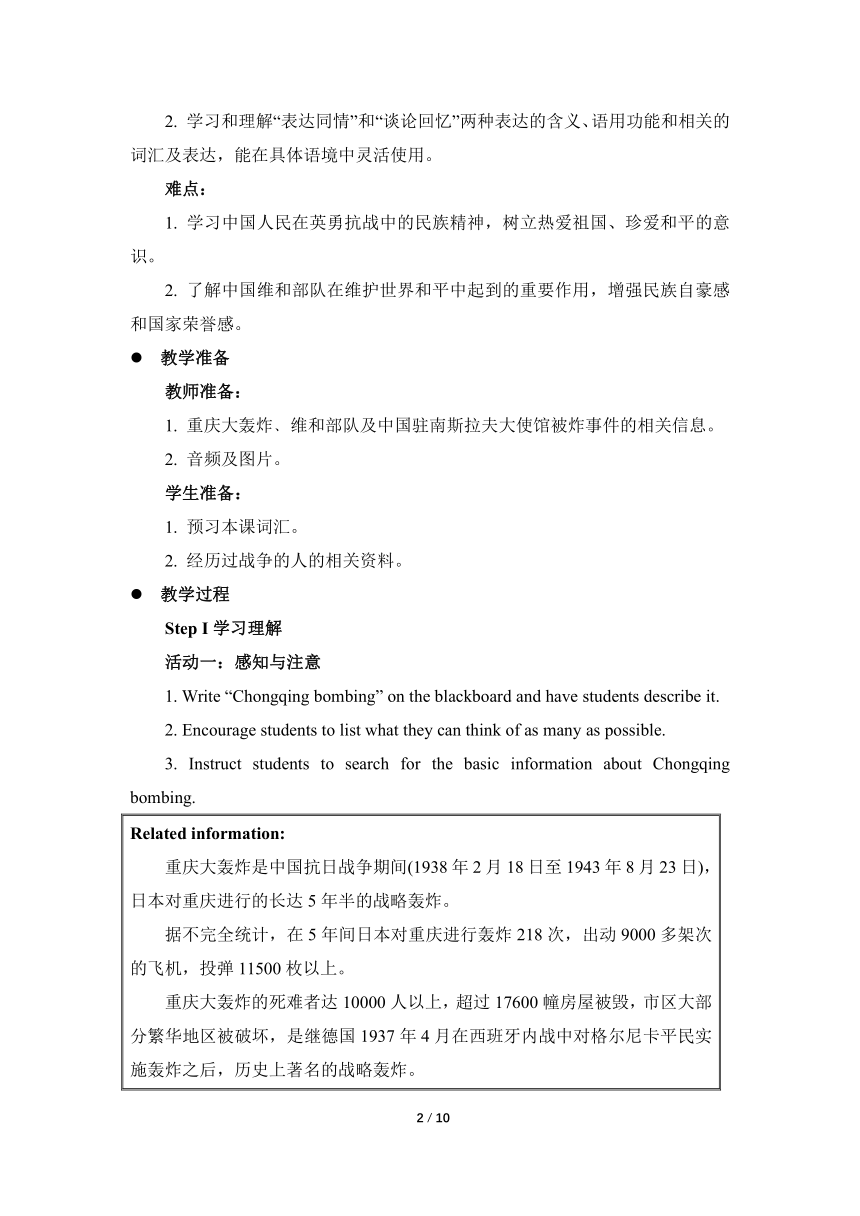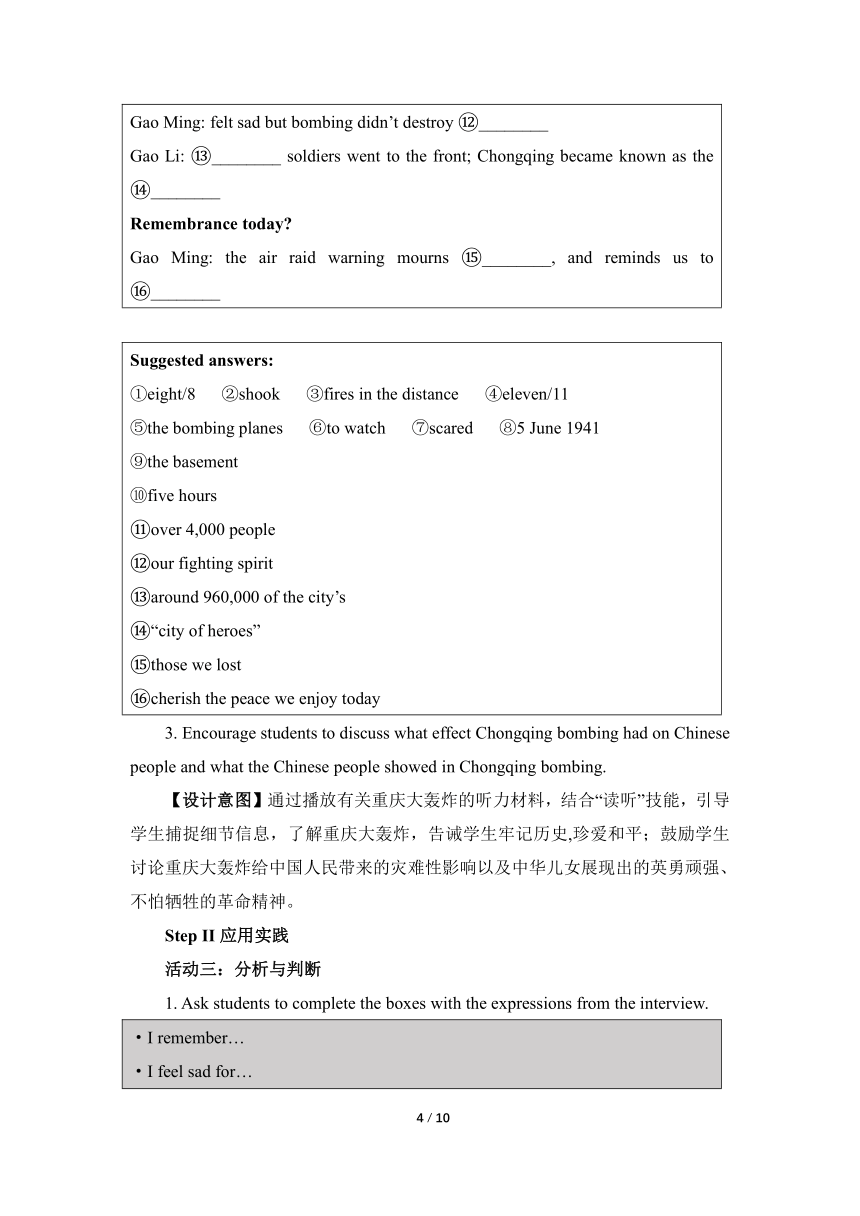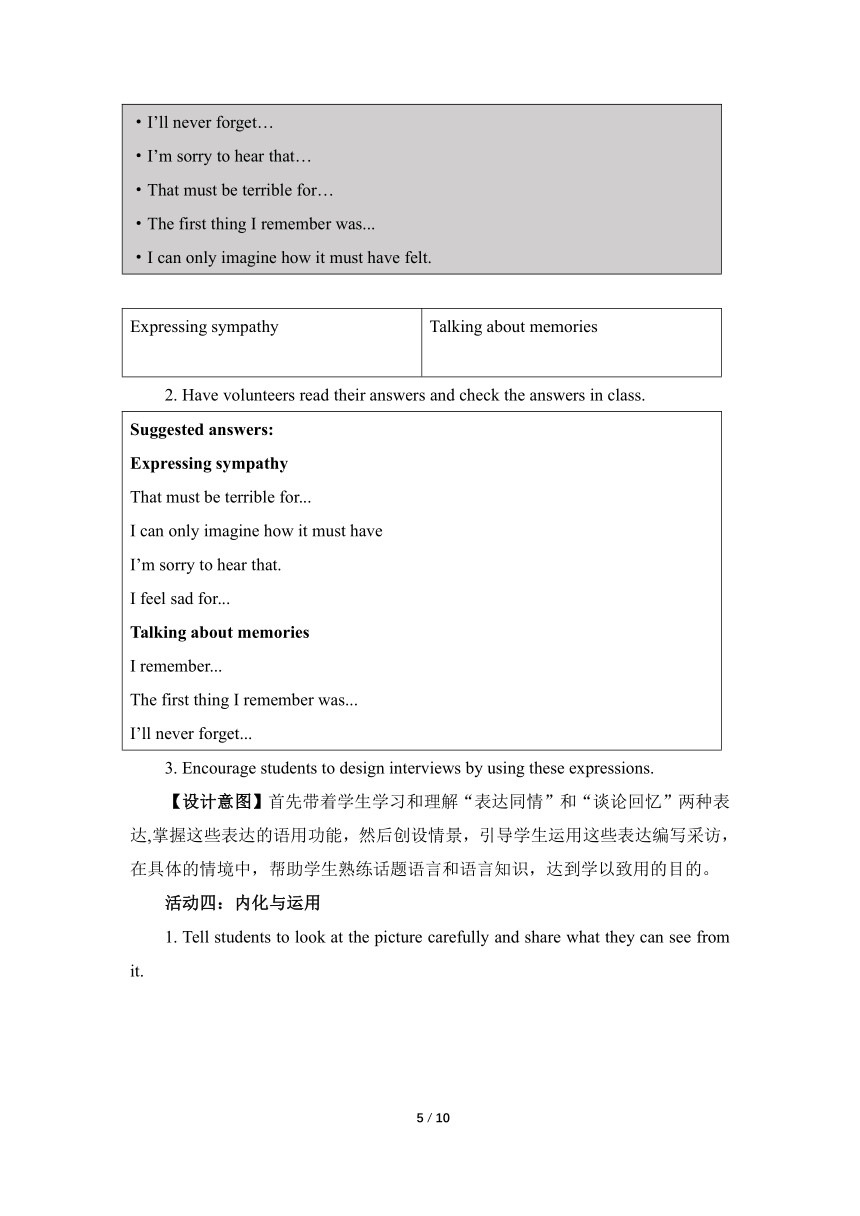外研版(2019)选择性必修第三册 Unit3 War and peace Using Language(2) 名师教学设计
文档属性
| 名称 | 外研版(2019)选择性必修第三册 Unit3 War and peace Using Language(2) 名师教学设计 |  | |
| 格式 | docx | ||
| 文件大小 | 1.2MB | ||
| 资源类型 | 教案 | ||
| 版本资源 | 外研版(2019) | ||
| 科目 | 英语 | ||
| 更新时间 | 2023-03-05 19:43:16 | ||
图片预览





文档简介
Unit 3 Using Language(2) 名师教学设计
课时内容
The road to peace
主题语境:人与社会
主题群:历史、社会与文化
子主题:战争与和平
语篇类型:图片﹑音频等
文本分析:
[what]本课时标题为The road to peace,为综合语言运用。首先听有关重庆大轰炸的音频,接着学习和理解“表达同情”和“谈论回忆”两种表达的含义及语用功能,然后阅读介绍联合国维和部队的语篇并学会相关的词汇与表达。
[Why]通过听力训练和阅读语篇,从多方面开阔学生的视野,进一步理解重庆大轰炸的残酷和联合国维和部队(尤其是中国维和部队)在维护世界和平过程中起的作用。
[How]本课包含一段听力材料和一个阅读语段,分别是代表“战争”与“和平”。听力活动的设置,由易到难,帮助学生从了解主旨大意到捕捉细节信息,层层渐进。阅读语段中包含了与主题相关的词汇和表达,有利于学生了解联合国维和部队的使命及其对世界和平起到的至关重要的作用。
课时目标
1. 了解重庆大轰炸音频的主旨大意和细节信息,发展听、读等技能。
2. 学习和理解“表达同情”和“谈论回忆”两种表达的含义及语用功能,并能在具体语境中灵活使用。
3. 回顾重庆大轰炸,培养学生热爱祖国、珍爱和平的意识,学习中国人民在英勇抗战中体现出的民族精神。
4. 获取语段主旨大意,了解联合国维和部队(尤其是中国维和部队)的使命及其对世界和平起到的至关重要的作用,增强民族自豪感和国家荣誉感。
重点难点
重点:
1. 了解重庆大轰炸和联合国维和部队的相关信息。
2. 学习和理解“表达同情”和“谈论回忆”两种表达的含义、语用功能和相关的词汇及表达,能在具体语境中灵活使用。
难点:
1. 学习中国人民在英勇抗战中的民族精神,树立热爱祖国、珍爱和平的意识。
2. 了解中国维和部队在维护世界和平中起到的重要作用,增强民族自豪感和国家荣誉感。
教学准备
教师准备:
1. 重庆大轰炸﹑维和部队及中国驻南斯拉夫大使馆被炸事件的相关信息。
2. 音频及图片。
学生准备:
1. 预习本课词汇。
2. 经历过战争的人的相关资料。
教学过程
Step I学习理解
活动一:感知与注意
1. Write “Chongqing bombing” on the blackboard and have students describe it.
2. Encourage students to list what they can think of as many as possible.
3. Instruct students to search for the basic information about Chongqing bombing.
Related information: 重庆大轰炸是中国抗日战争期间(1938年2月18日至1943年8月23日),日本对重庆进行的长达5年半的战略轰炸。 据不完全统计,在5年间日本对重庆进行轰炸218次,出动9000多架次的飞机,投弹11500枚以上。 重庆大轰炸的死难者达10000人以上,超过17600幢房屋被毁,市区大部分繁华地区被破坏,是继德国1937年4月在西班牙内战中对格尔尼卡平民实施轰炸之后,历史上著名的战略轰炸。 2012年9月10日,重庆大轰炸15名受害者或其遗属正式起诉日本政府。2015年 2月25日,东京地方法院宣判重庆大轰炸民间索赔案一审结果,188名原告败诉。
4. Have students read the questions below.
·Who is being interviewed
·What is the relationship between the two interviewees
·What are they talking about
【设计意图】在黑板上写下Chongqing bombing,鼓励学生开展头脑风暴,描述重庆大轰炸,学习与之相关的背景知识和阅读问题,为下一步的听力活动做铺垫。
活动二:获取与梳理
1. Ask students to listen to the interview and answer the above questions. Then check the answers.
Suggested answers: ·Gao Li and Gao Ming. ·Brother and sister. ·They are talking about the five-year terror bombing campaign by Japanese forces in Chongqing during the War of Resistance against Japanese Aggression.
2. Have students work in pairs and listen again to complete the interviewer’s notes.
First memories of the Chongqing bombing Gao Li: ①________ years old; remembers the house ②________ saw ③________ Gao Ming: ④________ years old; the first thing he remembers was ⑤________; went out on the street ⑥________; first felt fascinated then ⑦________ The most terrible experience Gao Li: happened on ⑧________; stayed in ⑨________ and waited for ⑩________ in there; house destroyed and ________ killed Influence of bombing Gao Ming: felt sad but bombing didn’t destroy ________ Gao Li: ________ soldiers went to the front; Chongqing became known as the ________ Remembrance today Gao Ming: the air raid warning mourns ________, and reminds us to ________
Suggested answers: ①eight/8 ②shook ③fires in the distance ④eleven/11 ⑤the bombing planes ⑥to watch ⑦scared ⑧5 June 1941 ⑨the basement ⑩five hours over 4,000 people our fighting spirit around 960,000 of the city’s “city of heroes” those we lost cherish the peace we enjoy today
3. Encourage students to discuss what effect Chongqing bombing had on Chinese people and what the Chinese people showed in Chongqing bombing.
【设计意图】通过播放有关重庆大轰炸的听力材料,结合“读听”技能,引导学生捕捉细节信息,了解重庆大轰炸,告诫学生牢记历史,珍爱和平;鼓励学生讨论重庆大轰炸给中国人民带来的灾难性影响以及中华儿女展现出的英勇顽强、不怕牺牲的革命精神。
Step II应用实践
活动三:分析与判断
1. Ask students to complete the boxes with the expressions from the interview.
·I remember… ·I feel sad for… ·I’ll never forget… ·I’m sorry to hear that… ·That must be terrible for… ·The first thing I remember was... ·I can only imagine how it must have felt.
Expressing sympathy Talking about memories
2. Have volunteers read their answers and check the answers in class.
Suggested answers: Expressing sympathy That must be terrible for... I can only imagine how it must have I’m sorry to hear that. I feel sad for... Talking about memories I remember... The first thing I remember was... I’ll never forget...
3. Encourage students to design interviews by using these expressions.
【设计意图】首先带着学生学习和理解“表达同情”和“谈论回忆”两种表达,掌握这些表达的语用功能,然后创设情景,引导学生运用这些表达编写采访,在具体的情境中,帮助学生熟练话题语言和语言知识,达到学以致用的目的。
活动四:内化与运用
1. Tell students to look at the picture carefully and share what they can see from it.
2. Have students look for related information about their discussion and share in class.
Related information: 联合国维持和平部队是根据有关联合国决议建立的一支跨国界的特种部队,成立于1956年苏伊士危机之际。联合国维持和平始于1948年6月,当时安全理事会授权在中东部署联合国军事观察员,其受联合国大会或安全理事会的委派,活跃于国际上有冲突的地区。特派团的任务是监督以色列与其阿拉伯邻邦之间的《停战协定》——这一行动被称为联合国停战监督组织。自此,联合国已部署了69个维持和平行动,其中56个是1988年以来开展的。近些年,共有数十万名军事人员和数万名联合国警察以及来自超过120个国家的文职人员参加了联合国维持和平行动。 维和部队士兵头戴天蓝色钢盔或蓝色贝雷帽,上有联合国英文缩写“UN”,臂章缀有“地球与橄榄枝”图案。凡参加联合国维持和平部队的人员,必须被送到设于北欧四国的训练中心接受特种训练,以熟悉维和部队的职能﹑宗旨、任务和进行特种军事训练。中国维和部队,是中国根据联合国有关决议和国际法准则,派出的军事部队,主要任务是制止冲突,恢复和平。应联合国秘书长请求,中国自1990年开始,每年向联合国派遣军事观察员执行维和任务。
3. Ask students to read the introduction to UN peacekeeping and discuss the questions below.
·What is the significance of UN peacekeeping missions
·What role is China playing in UN peacekeeping
4. Let students who could do well in English share answers in class.
Suggested answers: ·UN peacekeeping missions aim to give stability to conflict zones and allow governments to reestablish authority. ·China is playing an increasingly important role in UN peacekeeping and it has trained 8,000 troops who are kept on standby for UN missions.
【设计意图】通过观察图片和阅读文本,学习词汇和表达,了解联合国维和部队的使命和意义,获悉中国维和部队在维护世界和平中付出的努力和起到的作用,感受中国军人的职责和伟大,增强民族自豪感和国家荣誉感,从而进一步理解主题意义。
Step III迁移创新
活动五:推理与论证
1. Lead students to learn the words and expressions below.
peacekeeping missions friction warring parties reestablish kept on standby peace process civil wars conflict zones authority peacekeeping forces
2. Encourage students to make sentences or make up stories with these words and expressions.
3. Ask students to complete the fact file about UN’s peacekeeping mission in Liberia with the correct form of these words and expressions.
Why we came Liberia suffered two ①________ from 1989 to 2003, causing half the population to flee their homes, and the economy to collapse. We carried out this ②________ to monitor the ③________ in Liberia. What we did We stabilised the ④________ by: ·disarming combatants ·securing weapons and ammunition Why we are leaving The professionalism of our ⑤________ has stabilized the situation. Government authority has been ⑥________
Suggested answers: ①civil wars ②peacekeeping mission ③peace process ④conflict zones ⑤peacekeeping forces ⑥reestablished
【设计意图】学习与维和部队及战争有关的词汇和表达后,鼓励学生造句或编写故事,强化语感,提高词语的运用能力。然后要求学生阅读事实档案,理解其大意,并使用这些词汇和表达的正确形式填空,加深对维和部队的认识。
活动六:想象与创造
1. Ask students to work in pairs and find out about someone’s experiences in war.
2. Encourage students to do further research on the Internet if necessary.
3. Have students act out an interview based on the information they have found and use the words and expressions in this section.
4. Tell students to comment on each other’s performances and think about how they collected useful information.
【设计意图】先引导学生利用多种渠道查找战争亲历者的信息,然后运用本课所学词汇和表达,撰写一篇访谈并表演访谈,最后学生之间进行互评。通过以上活动帮助学生自主高效地开展学习,实现知识和能力的迁移,促进语言运用的自动化。
5. Talk about the May 8th Incident that our Chinese embassy in Yugoslavia was bombed in 1999 by the NATO and discuss what they can learn from it.
Related information: 北京时间1999年5月8日清晨5时45分,以美国为首的北约悍然对我国驻南斯拉夫联盟共和国大使馆进行轰炸!第一枚炸弹爆炸,使馆武官任宝凯重伤;第二枚爆炸,新华社记者邵云环牺牲;第三枚从使馆顶部贯穿数层楼板之后爆炸;几乎在同时,第四枚爆炸,《光明日报》记者许杏虎、朱颖牺牲;第五枚,不幸中的万幸,是一颗哑弹,驻南联盟大使潘占林与数十名使领馆工作人员幸免于难。 中国驻塞尔维亚使馆举行缅怀邵云环、许杏虎和朱颖三位烈士纪念活动
【设计意图】通过展示“五八”事件的相关信息和图片,鼓励学生谈论“五八”事件并发表自己的感受,使学生明白:三位烈士的鲜血激励着每一个中国人团结奋斗,为建设更加强大的国家而努力,我们的铭记是对他们最好的缅怀,我们的奋进是对他们最好的告慰,青少年应铭记历史,珍爱和平。
板书设计
Unit 3 War and peace Period III Using language (2) I. 学习理解 活动一:感知与注意 Talk about “Chongqing bombing”. 活动二:获取与梳理 Listen to the interview. Ⅱ. 应用实践 活动三:分析与判断 1. Complete the boxes. 2. Check the answers. 3. Design interviews. 活动四:内化与运用 Ⅲ. 迁移创新 活动五:推理与论证 1. Learn the words and expressions. 2. Make sentences or make up stories. 3. Complete the fact file. 活动六:想象与创造 1. Find out about someone's experiences in war. 2. Do further research. 3. Act out an interview. 4. Comment. 5. Talk about the May 8th Incident.
4 / 4
课时内容
The road to peace
主题语境:人与社会
主题群:历史、社会与文化
子主题:战争与和平
语篇类型:图片﹑音频等
文本分析:
[what]本课时标题为The road to peace,为综合语言运用。首先听有关重庆大轰炸的音频,接着学习和理解“表达同情”和“谈论回忆”两种表达的含义及语用功能,然后阅读介绍联合国维和部队的语篇并学会相关的词汇与表达。
[Why]通过听力训练和阅读语篇,从多方面开阔学生的视野,进一步理解重庆大轰炸的残酷和联合国维和部队(尤其是中国维和部队)在维护世界和平过程中起的作用。
[How]本课包含一段听力材料和一个阅读语段,分别是代表“战争”与“和平”。听力活动的设置,由易到难,帮助学生从了解主旨大意到捕捉细节信息,层层渐进。阅读语段中包含了与主题相关的词汇和表达,有利于学生了解联合国维和部队的使命及其对世界和平起到的至关重要的作用。
课时目标
1. 了解重庆大轰炸音频的主旨大意和细节信息,发展听、读等技能。
2. 学习和理解“表达同情”和“谈论回忆”两种表达的含义及语用功能,并能在具体语境中灵活使用。
3. 回顾重庆大轰炸,培养学生热爱祖国、珍爱和平的意识,学习中国人民在英勇抗战中体现出的民族精神。
4. 获取语段主旨大意,了解联合国维和部队(尤其是中国维和部队)的使命及其对世界和平起到的至关重要的作用,增强民族自豪感和国家荣誉感。
重点难点
重点:
1. 了解重庆大轰炸和联合国维和部队的相关信息。
2. 学习和理解“表达同情”和“谈论回忆”两种表达的含义、语用功能和相关的词汇及表达,能在具体语境中灵活使用。
难点:
1. 学习中国人民在英勇抗战中的民族精神,树立热爱祖国、珍爱和平的意识。
2. 了解中国维和部队在维护世界和平中起到的重要作用,增强民族自豪感和国家荣誉感。
教学准备
教师准备:
1. 重庆大轰炸﹑维和部队及中国驻南斯拉夫大使馆被炸事件的相关信息。
2. 音频及图片。
学生准备:
1. 预习本课词汇。
2. 经历过战争的人的相关资料。
教学过程
Step I学习理解
活动一:感知与注意
1. Write “Chongqing bombing” on the blackboard and have students describe it.
2. Encourage students to list what they can think of as many as possible.
3. Instruct students to search for the basic information about Chongqing bombing.
Related information: 重庆大轰炸是中国抗日战争期间(1938年2月18日至1943年8月23日),日本对重庆进行的长达5年半的战略轰炸。 据不完全统计,在5年间日本对重庆进行轰炸218次,出动9000多架次的飞机,投弹11500枚以上。 重庆大轰炸的死难者达10000人以上,超过17600幢房屋被毁,市区大部分繁华地区被破坏,是继德国1937年4月在西班牙内战中对格尔尼卡平民实施轰炸之后,历史上著名的战略轰炸。 2012年9月10日,重庆大轰炸15名受害者或其遗属正式起诉日本政府。2015年 2月25日,东京地方法院宣判重庆大轰炸民间索赔案一审结果,188名原告败诉。
4. Have students read the questions below.
·Who is being interviewed
·What is the relationship between the two interviewees
·What are they talking about
【设计意图】在黑板上写下Chongqing bombing,鼓励学生开展头脑风暴,描述重庆大轰炸,学习与之相关的背景知识和阅读问题,为下一步的听力活动做铺垫。
活动二:获取与梳理
1. Ask students to listen to the interview and answer the above questions. Then check the answers.
Suggested answers: ·Gao Li and Gao Ming. ·Brother and sister. ·They are talking about the five-year terror bombing campaign by Japanese forces in Chongqing during the War of Resistance against Japanese Aggression.
2. Have students work in pairs and listen again to complete the interviewer’s notes.
First memories of the Chongqing bombing Gao Li: ①________ years old; remembers the house ②________ saw ③________ Gao Ming: ④________ years old; the first thing he remembers was ⑤________; went out on the street ⑥________; first felt fascinated then ⑦________ The most terrible experience Gao Li: happened on ⑧________; stayed in ⑨________ and waited for ⑩________ in there; house destroyed and ________ killed Influence of bombing Gao Ming: felt sad but bombing didn’t destroy ________ Gao Li: ________ soldiers went to the front; Chongqing became known as the ________ Remembrance today Gao Ming: the air raid warning mourns ________, and reminds us to ________
Suggested answers: ①eight/8 ②shook ③fires in the distance ④eleven/11 ⑤the bombing planes ⑥to watch ⑦scared ⑧5 June 1941 ⑨the basement ⑩five hours over 4,000 people our fighting spirit around 960,000 of the city’s “city of heroes” those we lost cherish the peace we enjoy today
3. Encourage students to discuss what effect Chongqing bombing had on Chinese people and what the Chinese people showed in Chongqing bombing.
【设计意图】通过播放有关重庆大轰炸的听力材料,结合“读听”技能,引导学生捕捉细节信息,了解重庆大轰炸,告诫学生牢记历史,珍爱和平;鼓励学生讨论重庆大轰炸给中国人民带来的灾难性影响以及中华儿女展现出的英勇顽强、不怕牺牲的革命精神。
Step II应用实践
活动三:分析与判断
1. Ask students to complete the boxes with the expressions from the interview.
·I remember… ·I feel sad for… ·I’ll never forget… ·I’m sorry to hear that… ·That must be terrible for… ·The first thing I remember was... ·I can only imagine how it must have felt.
Expressing sympathy Talking about memories
2. Have volunteers read their answers and check the answers in class.
Suggested answers: Expressing sympathy That must be terrible for... I can only imagine how it must have I’m sorry to hear that. I feel sad for... Talking about memories I remember... The first thing I remember was... I’ll never forget...
3. Encourage students to design interviews by using these expressions.
【设计意图】首先带着学生学习和理解“表达同情”和“谈论回忆”两种表达,掌握这些表达的语用功能,然后创设情景,引导学生运用这些表达编写采访,在具体的情境中,帮助学生熟练话题语言和语言知识,达到学以致用的目的。
活动四:内化与运用
1. Tell students to look at the picture carefully and share what they can see from it.
2. Have students look for related information about their discussion and share in class.
Related information: 联合国维持和平部队是根据有关联合国决议建立的一支跨国界的特种部队,成立于1956年苏伊士危机之际。联合国维持和平始于1948年6月,当时安全理事会授权在中东部署联合国军事观察员,其受联合国大会或安全理事会的委派,活跃于国际上有冲突的地区。特派团的任务是监督以色列与其阿拉伯邻邦之间的《停战协定》——这一行动被称为联合国停战监督组织。自此,联合国已部署了69个维持和平行动,其中56个是1988年以来开展的。近些年,共有数十万名军事人员和数万名联合国警察以及来自超过120个国家的文职人员参加了联合国维持和平行动。 维和部队士兵头戴天蓝色钢盔或蓝色贝雷帽,上有联合国英文缩写“UN”,臂章缀有“地球与橄榄枝”图案。凡参加联合国维持和平部队的人员,必须被送到设于北欧四国的训练中心接受特种训练,以熟悉维和部队的职能﹑宗旨、任务和进行特种军事训练。中国维和部队,是中国根据联合国有关决议和国际法准则,派出的军事部队,主要任务是制止冲突,恢复和平。应联合国秘书长请求,中国自1990年开始,每年向联合国派遣军事观察员执行维和任务。
3. Ask students to read the introduction to UN peacekeeping and discuss the questions below.
·What is the significance of UN peacekeeping missions
·What role is China playing in UN peacekeeping
4. Let students who could do well in English share answers in class.
Suggested answers: ·UN peacekeeping missions aim to give stability to conflict zones and allow governments to reestablish authority. ·China is playing an increasingly important role in UN peacekeeping and it has trained 8,000 troops who are kept on standby for UN missions.
【设计意图】通过观察图片和阅读文本,学习词汇和表达,了解联合国维和部队的使命和意义,获悉中国维和部队在维护世界和平中付出的努力和起到的作用,感受中国军人的职责和伟大,增强民族自豪感和国家荣誉感,从而进一步理解主题意义。
Step III迁移创新
活动五:推理与论证
1. Lead students to learn the words and expressions below.
peacekeeping missions friction warring parties reestablish kept on standby peace process civil wars conflict zones authority peacekeeping forces
2. Encourage students to make sentences or make up stories with these words and expressions.
3. Ask students to complete the fact file about UN’s peacekeeping mission in Liberia with the correct form of these words and expressions.
Why we came Liberia suffered two ①________ from 1989 to 2003, causing half the population to flee their homes, and the economy to collapse. We carried out this ②________ to monitor the ③________ in Liberia. What we did We stabilised the ④________ by: ·disarming combatants ·securing weapons and ammunition Why we are leaving The professionalism of our ⑤________ has stabilized the situation. Government authority has been ⑥________
Suggested answers: ①civil wars ②peacekeeping mission ③peace process ④conflict zones ⑤peacekeeping forces ⑥reestablished
【设计意图】学习与维和部队及战争有关的词汇和表达后,鼓励学生造句或编写故事,强化语感,提高词语的运用能力。然后要求学生阅读事实档案,理解其大意,并使用这些词汇和表达的正确形式填空,加深对维和部队的认识。
活动六:想象与创造
1. Ask students to work in pairs and find out about someone’s experiences in war.
2. Encourage students to do further research on the Internet if necessary.
3. Have students act out an interview based on the information they have found and use the words and expressions in this section.
4. Tell students to comment on each other’s performances and think about how they collected useful information.
【设计意图】先引导学生利用多种渠道查找战争亲历者的信息,然后运用本课所学词汇和表达,撰写一篇访谈并表演访谈,最后学生之间进行互评。通过以上活动帮助学生自主高效地开展学习,实现知识和能力的迁移,促进语言运用的自动化。
5. Talk about the May 8th Incident that our Chinese embassy in Yugoslavia was bombed in 1999 by the NATO and discuss what they can learn from it.
Related information: 北京时间1999年5月8日清晨5时45分,以美国为首的北约悍然对我国驻南斯拉夫联盟共和国大使馆进行轰炸!第一枚炸弹爆炸,使馆武官任宝凯重伤;第二枚爆炸,新华社记者邵云环牺牲;第三枚从使馆顶部贯穿数层楼板之后爆炸;几乎在同时,第四枚爆炸,《光明日报》记者许杏虎、朱颖牺牲;第五枚,不幸中的万幸,是一颗哑弹,驻南联盟大使潘占林与数十名使领馆工作人员幸免于难。 中国驻塞尔维亚使馆举行缅怀邵云环、许杏虎和朱颖三位烈士纪念活动
【设计意图】通过展示“五八”事件的相关信息和图片,鼓励学生谈论“五八”事件并发表自己的感受,使学生明白:三位烈士的鲜血激励着每一个中国人团结奋斗,为建设更加强大的国家而努力,我们的铭记是对他们最好的缅怀,我们的奋进是对他们最好的告慰,青少年应铭记历史,珍爱和平。
板书设计
Unit 3 War and peace Period III Using language (2) I. 学习理解 活动一:感知与注意 Talk about “Chongqing bombing”. 活动二:获取与梳理 Listen to the interview. Ⅱ. 应用实践 活动三:分析与判断 1. Complete the boxes. 2. Check the answers. 3. Design interviews. 活动四:内化与运用 Ⅲ. 迁移创新 活动五:推理与论证 1. Learn the words and expressions. 2. Make sentences or make up stories. 3. Complete the fact file. 活动六:想象与创造 1. Find out about someone's experiences in war. 2. Do further research. 3. Act out an interview. 4. Comment. 5. Talk about the May 8th Incident.
4 / 4
